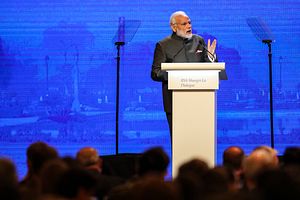On February 1, India’s acting Finance Minister Piyush Goyal (presented the Indian interim budget for 2019-20. Unsurprisingly for an election year, there was a big focus on agriculture and social sectors, and the defense allocation was certainly not the highlight.
Specifically, Goyal, in his speech said, “Our Defence Budget will be crossing 3,00,000 crore rupees [INR 3 trillion or about $42 billion] for the first time in 2019-20. For securing our borders and to maintain preparedness of the highest order, if necessary, additional funds would be provided.”
Newspaper headlines highlighted the fact that the defense budget had crossed the INR 3 trillion mark. But the key question is if this is sufficient against the backdrop of growing security challenges and the life-cycle driven military modernization that Indian military forces urgently require.
In fact, the defense allocation in real terms has gone down if one were to look at the rate of inflation and foreign exchange depreciation over the last year. Commenting on the defense budget, Air Marshal Nirdosh Tyagi, a former Deputy Chief of Air Staff, said, “Last defence budget had increase of just about 7.7 percent over the previous year. Inflation and rupee depreciation more than neutralized this. Thus, no increase in real terms.” Other commentators also echoed this general sentiment that Indian defense budget has stagnated.
With major plans for defense modernization on the anvil, the current defense allocation is far too meager to make any meaningful progress. In fact, in the last few years, each Indian defense budget has been criticized as being the lowest budget allocation since the 1962 war with China. Indian defense spending in the pre-1962 phase was about 1.5 percent of GDP annually, going up only as a consequence of the disastrous border war with China in late 1962 and the rebuilding of the Indian military that took place subsequently. It peaked at over 4 percent of GDP in the mid-1980s, according to the World Bank (based on SIPRI data), declining since then.
The government has made a total allocation for defense of INR 4.31 trillion which is slightly over 6.35 percent of the revised estimates for 2018-19. The total Ministry of Defense (MoD) budget includes all allocations to the Ministry of Defense, revenue allocations to the three services, Defense R&D Organization (DRDO) and Ordnance Factories and capital allocations to these entities and also defense pensions. Thus, the actual allocation for the defense forces is only INR 3.01 trillion, of which only a third (INR 1.03 trillion) is allocated for capital expenditure, which goes into modernization of the military.
Analysts have provided further break down of the budget in terms of the modernization funds available to army, navy and air force which shows that the resource crunch will continue to be a major problem for all the services. Most of the 6.3 percent hike in the defense budget actually goes to meet the salary and pension requirements, thus making the allocation for modernization a lot smaller than even the previous year. A quick look at the modernization budget shows that Air Force has got the largest share at INR 363.7 billion followed by Army and the Navy at about INR 220 billion.
Why does the continuing almost-stagnant defense allocation create anxieties? This year’s defense allocation is despite the Parliament Committee Report of 2018 which highlighted the serious deficiencies faced by the Indian military. India’s Vice Chief of Army Staff, Lt. Gen. Sarath Chand had last year made a case for increasing the budget, telling a parliamentary panel that the budget “has dashed our hopes”. He pointed to the possibility of a two-front war and to the continuing threats that India faced, saying India did not have sufficient funds for emergency necessary purchases, and the army did not have sufficient war reserves to fight a high-intensity war for more than ten days. He is not likely to be pleased with this year’s budget either.
More recently, the Indian Army has released its Land Warfare doctrine which clearly emphasizes a two-front threat scenario (China-Pakistan) for which the Indian Army has to be prepared against, signifying a shift from the single-threat scenario, which was the predominant thinking until a decade ago. Similarly, last year the Indian Air Force (IAF) conducted the Gagan Shakti exercises reportedly with a two-front war scenario.
It is somewhat surprising that a nationalist government that prides itself on a muscular foreign policy devotes so little for defense. While the current budget may be dictated by the impending elections and the need for providing sops to various domestic groups, that does not explain the consistently lower defense budget for several years. This also has an impact on India’s strategic options: India’s much softer approach to China over the last year may very well be dictated by the realization that New Delhi simply does not have the military capacity to do anything else.

































